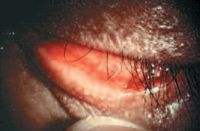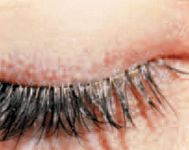Article
Topical cyclosporine may relieve ocular rosacea symptoms
Patients treated with cyclosporine had greater symptomatic improvement compared with controls using preservative-free artificial tears.
Fort Lauderdale, FL-Cyclosporine 0.05% ophthalmic emulsion (Restasis, Allergan) can effectively improve the signs and symptoms of ocular rosacea in many patients whose condition is refractory to other treatments, said Henry D. Perry, MD, at the annual meeting of the Association for Research in Vision and Ophthalmology.

During follow-up averaging 11.8 months and extending up to 17 months, 44 (80%) patients benefited with at least mild improvement in disease signs and symptoms, and of those with a response, 32 (73%) were able either to discontinue all medications (two patients, 5%) or to continue maintenance with cyclosporine as monotherapy (30 patients, 68%). The rest (12 patients, 29%) are continuing with low-dose oral tetracycline plus the cyclosporine. Only two patients have experienced relapses but they have been able to control sporadic disease flares with short-course topical corticosteroid treatment.

The presence of ocular rosacea was an exclusion criterion for patient enrollment in the pivotal trials that led to marketing approval of cyclosporine ophthalmic emulsion for the treatment of suppressed tear production associated with keratoconjunctivitis sicca. However, noticing that patients with symptomatic meibomiam gland dysfunction (posterior blepharitis) seemed to have
a good response to topical cyclosporine, several years ago, Dr. Perry and his colleagues undertook a double-masked, randomized, placebo-controlled study to evaluate its efficacy further in that setting [Cornea, in press]. That trial included 34 patients, and the results showed that after 3 months, patients treated with cyclosporine had greater symptomatic improvement compared with controls using preservative-free artificial tears, along with statistically significantly greater reductions in meibomian gland inclusions, lid margin vascular injection, tarsal telangiectasias, and fluorescein staining.
"About half of the patients in that trial had rosacea, and so we undertook this retrospective study to evaluate the efficacy of topical cyclosporine in a larger cohort of patients with rosacea," Dr. Perry said.

Clinical response to cyclosporine was evaluated using a grading system taking into account changes in disease signs and symptoms.
Newsletter
Don’t miss out—get Ophthalmology Times updates on the latest clinical advancements and expert interviews, straight to your inbox.





